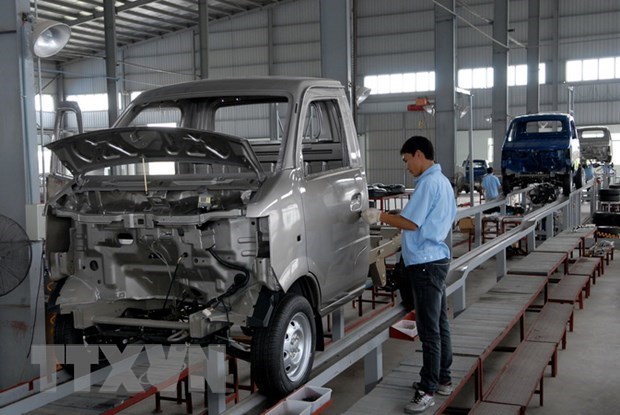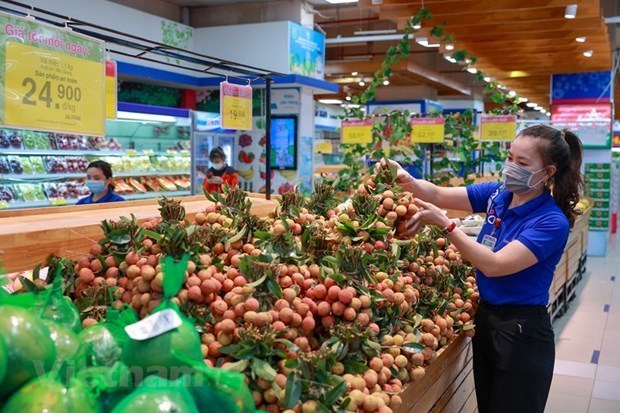Inflationary pressure poses big challenge to economy
Escalating geopolitical tensions in the world may negatively affect economic activities and inflation in Vietnam due to weaker external demand, higher prices of commodities, and disrupted supply chains.
 In the first half of 2022, some sectors recorded faster growth compared to the pre-pandemic period such as the processing - manufacturing industry which expanded by 9.7%. (Photo: VNA)
In the first half of 2022, some sectors recorded faster growth compared to the pre-pandemic period such as the processing - manufacturing industry which expanded by 9.7%. (Photo: VNA)Even growth among sectors
GSO General Director Nguyen Thi Huong said most of socio-economic aspects have bounced back. Some sectors showed faster growth in the first six months compared to the pre-pandemic period, including processing - manufacturing up 9.7%, finance - banking - insurance 9.5%, accommodation and restaurant services 11%, and wholesaling - retailing 5.82%.
During the first six months of the year, the country’s gross domestic product (GDP) increased 6.42%, faster than the respective rates of 2.04% and 5.74% in the same periods of 2020 and 2021.
Dr. Can Van Luc, member of the National Financial and Monetary Policy Advisory Council, said Vietnam’s growth has been driven by both supply and demand.
In terms of supply, the two pillars are the processing - manufacturing and service sectors, he noted, adding that the tourism industry has been recovering fast with accommodation services, restaurant services, and retailing almost returning to pre-pandemic levels.
In terms of demand, export revenue has kept rising while investment and purchasing power have also been rebounding.
Another positive factor is that exchange rates of the Vietnamese dong have stayed more stable than the nominal value of many other currencies. While many foreign currencies have lost 3 - 8%, even over 10%, of their nominal values, exchange rates of the Vietnamese dong are forecast to increase just 2 - 2.3%, or 2.5%, from now to the year’s end, according to the economist.
He also stressed that domestic enterprises are also recovering well, with the numbers of newly-established firms and those resuming operations rising sharply. The Government is also pushing ahead with the socio-economic recovery and development programme for 2022 - 2023, along with public investment and the programmes on digital, green, and circular economy development and integration.
Echoing the view, Tran Khanh Hien, director for research and analysis at the VNDirect Securities Corporation, said the service, tourism, and aviation sectors will enjoy good growth in the latter half of 2022. The disbursement of public investment will be a bright spot in the fourth quarter thanks to lower prices of construction materials. This is despite slow progress during the first six months.
In its Global Economic Prospects report in June, the World Bank (WB) predicted Vietnam’s growth this year at 5.8%, higher than the forecasts for the Philippines, Malaysia, and Thailand. The International Monetary Fund (IMF) projected a rate of 6%, and the Asian Development Bank (ADB) and the ASEAN+3 Macroeconomic Research Office (AMRO) 6.5%.
Inflationary pressure
 Higher demand for goods and services will drive prices in the remaining months of 2022. (Photo: VietnamPlus)
Higher demand for goods and services will drive prices in the remaining months of 2022. (Photo: VietnamPlus)GDO General Director Nguyen Thi Huong noted the six-month consumer price index (CPI) increased 2.44% year on year. The strong economic and production recovery and impacts of global prices have boosted prices of essential goods and services, but generally speaking, prices are still under control.
According to IMF, external risks, firstly escalating geopolitical tensions in the world, may negatively affect economic activities and inflation in Vietnam due to weaker external demand, higher prices of commodities, and prolonged disruptions to supply chains. Other risks include growth slowdown in China, new variants of COVID-19, tightened global financial conditions, and developments in the domestic real estate and corporate bond markets.
IMF recommended that, to cope with inflationary pressure, Vietnam should rely on fiscal policies and carry out structural reforms to achieve sustainable and inclusive growth.
Dr. Nguyen Tri Hieu said as inflation is projected to reach 3.1% in Q3, the State Bank of Vietnam does not have much room left to keep inflation under 4% for the whole year as fuel prices and daily expenses rise. Global prices of commodities are also surging, and with the uptrend in the country’s imports, imported inflation could also be a drag on the economy.
Therefore, keeping inflation under 4% is a very big challenge, he added.
Huong said to deal with mounting inflationary pressure, the Government has urged ministries, sectors, and localities to carry out concerted price stabilisation measures to help stabilise production and business activities, as well as people’s daily life.
Thanks to effects of growth aid packages, the Vietnamese economy may bounce back in the remaining months, but higher demand will fuel goods prices.
She suggested authorities conduct price management and governance in a prudent, proactive, and flexible manner to ensure that CPI growth will not exceed the ceiling limit of 4% as targeted by the National Assembly.
Experts also held that the Government should implement temporary support measures, including assisting poor households to cope with rising fuel prices./.













